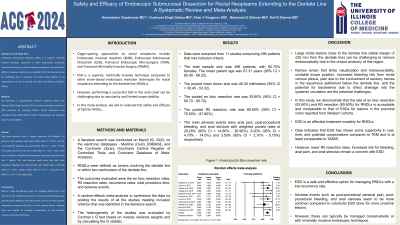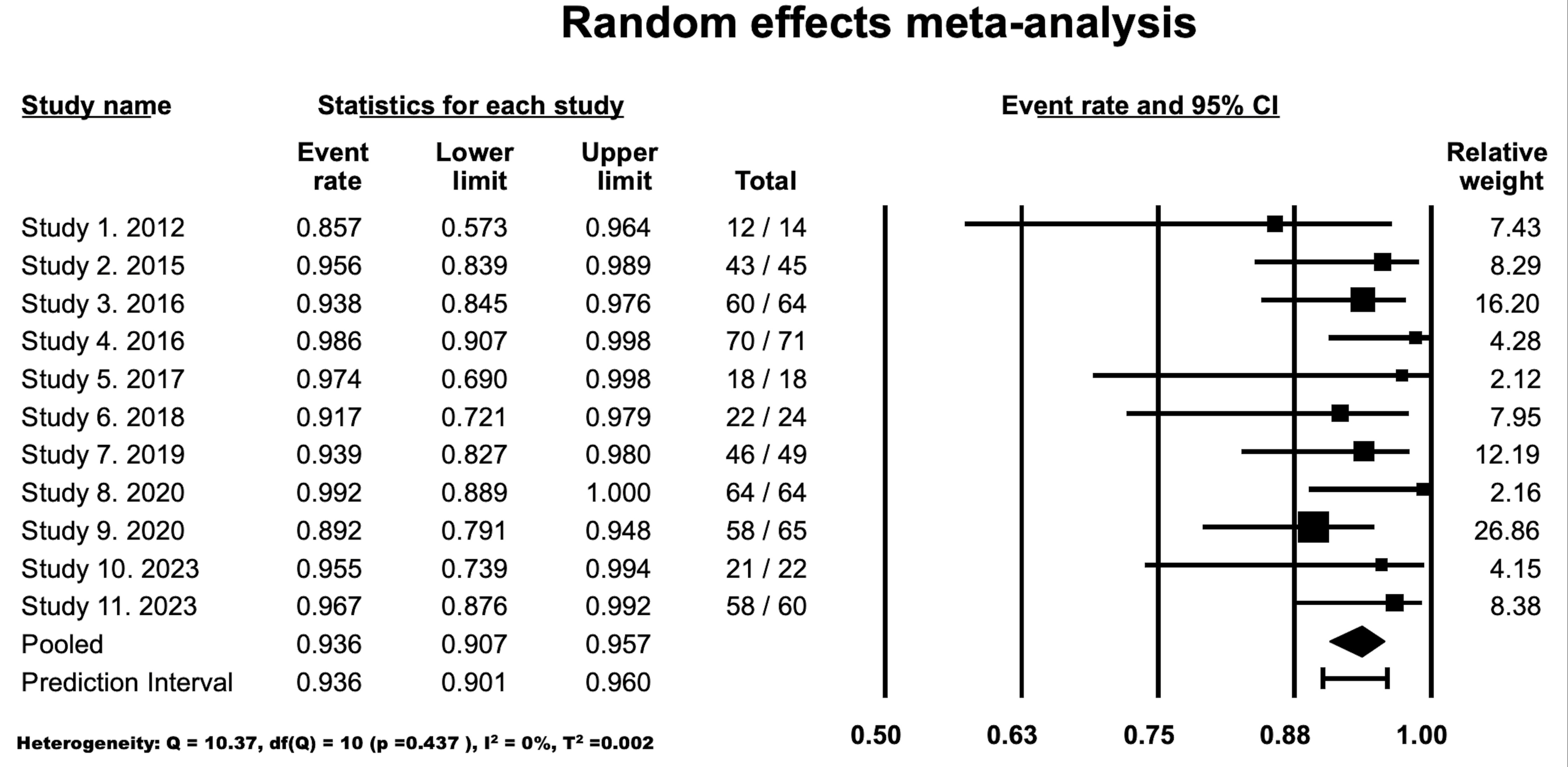Sunday Poster Session
Category: Interventional Endoscopy
P1038 - Endoscopic Submucosal Dissection (ESD) for Rectal Neoplasms Extending to the Dentate Line: A Systematic Review and Meta-Analysis
Sunday, October 27, 2024
3:30 PM - 7:00 PM ET
Location: Exhibit Hall E

Has Audio

Harishankar Gopakumar, MD
University of Illinois College of Medicine
Bloomington, IL
Presenting Author(s)
Harishankar Gopakumar, MD1, Dushyant S. Dahiya, MD2, Peter V Draganov, MD3, Mohamed Othman, MD4, Neil R Sharma, MD, FACG5
1University of Illinois College of Medicine, Bloomington, IL; 2The University of Kansas School of Medicine, Kansas City, KS; 3University of Florida, Gainesville, FL; 4Baylor College of Medicine, Houston, TX; 5IOSE. Peak Gastroenterology & Gastrocare Partners., Colorado Springs, CO
Introduction: Endoscopic submucosal dissection (ESD) is a superior, minimally invasive technique compared to other snare-based endoscopic resection techniques for rectal neoplasms extending to the dentate line (RNDLs). However, performing a successful ESD in the anal canal can be challenging due to vascularity and limited scope stability. In this meta-analysis, we aim to evaluate the safety and efficacy of ESD for RNDLs.
Methods: We performed a comprehensive electronic database search from January 2005 through January 2024 for studies evaluating outcomes of ESD performed for managing RNDLs. Pooled proportions were calculated using random-effects models. Heterogeneity was evaluated using I2 and Q statistics.
Results: Data were extracted from 11 studies comprising 496 patients. The pooled en bloc resection rates were 93.60% (95% CI = 90.70 - 95.70) (Figure 1). The pooled R0 resection rate was 80.60% (95% CI = 70.50% - 87.80%). The pooled recurrence rate was 4.00% (95% CI = 2.40% - 6.50%). There was no evidence of significant heterogeneity calculated using the Q-test and I2 statistic. The main adverse events were anal pain, post-procedural bleeding, and anal stricture with pooled rates of 20.20% (95% CI = 14.80% - 26.90%), 8.20% (95% CI = 4.70% - 14.0%) and 3.50% (95% CI = 2.10% - 5.70%) respectively.
Discussion: Endoscopic submucosal dissection (ESD) is now a well-established, minimally invasive technique for resecting large superficial colorectal neoplasms.However, large rectal lesions close to the dentate line (distal margin of ≤20 mm from the dentate line) can be challenging to remove endoscopically due to the unique anatomy of this region.In this systematic review and meta-analysis, we demonstrate that the rate of en bloc resection (93.60%) and R0 resection (80.60%) for RNDLs is acceptable and comparable to that of ESDs for lesions in the proximal colon reported from Western cohorts. In our study, the pooled local recurrence rate was 4%, which is within the expected range for the mean lesion size of about 46 millimeters based on previously published literature. ESD is a safe and effective option for managing RNDLs with a low recurrence rate. Adverse events such as post-procedural perianal pain, post-procedural bleeding, and anal stenosis seem to be more common compared to colorectal ESD done for more proximal lesions. However, these can typically be managed conservatively or with minimally invasive endoscopic techniques.

Disclosures:
Harishankar Gopakumar, MD1, Dushyant S. Dahiya, MD2, Peter V Draganov, MD3, Mohamed Othman, MD4, Neil R Sharma, MD, FACG5. P1038 - Endoscopic Submucosal Dissection (ESD) for Rectal Neoplasms Extending to the Dentate Line: A Systematic Review and Meta-Analysis, ACG 2024 Annual Scientific Meeting Abstracts. Philadelphia, PA: American College of Gastroenterology.
1University of Illinois College of Medicine, Bloomington, IL; 2The University of Kansas School of Medicine, Kansas City, KS; 3University of Florida, Gainesville, FL; 4Baylor College of Medicine, Houston, TX; 5IOSE. Peak Gastroenterology & Gastrocare Partners., Colorado Springs, CO
Introduction: Endoscopic submucosal dissection (ESD) is a superior, minimally invasive technique compared to other snare-based endoscopic resection techniques for rectal neoplasms extending to the dentate line (RNDLs). However, performing a successful ESD in the anal canal can be challenging due to vascularity and limited scope stability. In this meta-analysis, we aim to evaluate the safety and efficacy of ESD for RNDLs.
Methods: We performed a comprehensive electronic database search from January 2005 through January 2024 for studies evaluating outcomes of ESD performed for managing RNDLs. Pooled proportions were calculated using random-effects models. Heterogeneity was evaluated using I2 and Q statistics.
Results: Data were extracted from 11 studies comprising 496 patients. The pooled en bloc resection rates were 93.60% (95% CI = 90.70 - 95.70) (Figure 1). The pooled R0 resection rate was 80.60% (95% CI = 70.50% - 87.80%). The pooled recurrence rate was 4.00% (95% CI = 2.40% - 6.50%). There was no evidence of significant heterogeneity calculated using the Q-test and I2 statistic. The main adverse events were anal pain, post-procedural bleeding, and anal stricture with pooled rates of 20.20% (95% CI = 14.80% - 26.90%), 8.20% (95% CI = 4.70% - 14.0%) and 3.50% (95% CI = 2.10% - 5.70%) respectively.
Discussion: Endoscopic submucosal dissection (ESD) is now a well-established, minimally invasive technique for resecting large superficial colorectal neoplasms.However, large rectal lesions close to the dentate line (distal margin of ≤20 mm from the dentate line) can be challenging to remove endoscopically due to the unique anatomy of this region.In this systematic review and meta-analysis, we demonstrate that the rate of en bloc resection (93.60%) and R0 resection (80.60%) for RNDLs is acceptable and comparable to that of ESDs for lesions in the proximal colon reported from Western cohorts. In our study, the pooled local recurrence rate was 4%, which is within the expected range for the mean lesion size of about 46 millimeters based on previously published literature. ESD is a safe and effective option for managing RNDLs with a low recurrence rate. Adverse events such as post-procedural perianal pain, post-procedural bleeding, and anal stenosis seem to be more common compared to colorectal ESD done for more proximal lesions. However, these can typically be managed conservatively or with minimally invasive endoscopic techniques.

Figure: Figure 1. Forest plot showing individual study estimates and the pooled estimate for en bloc resection rate.
Disclosures:
Harishankar Gopakumar indicated no relevant financial relationships.
Dushyant Dahiya indicated no relevant financial relationships.
Peter V Draganov: Boston Scientific – Consultant. Cook Medical – Consultant. Fujifilm – Consultant. Medtronic – Consultant. Olympus – Consultant.
Mohamed Othman: Abbvie – Consultant. Abbvie – Grant/Research Support. Apollo Endosurgery – Consultant. Boston Scientific – Consultant. Boston Scientific – Grant/Research Support. ConMed – Grant/Research Support. Creo Medical – Consultant. Lucid Diagnostic – Grant/Research Support. Lumendi – Consultant. Nestle – Grant/Research Support. Olympus – Consultant.
Neil R Sharma: Boston Scientific – Consultant. Medtronic – Consultant. Olympus – Consultant. Steris – Consultant.
Harishankar Gopakumar, MD1, Dushyant S. Dahiya, MD2, Peter V Draganov, MD3, Mohamed Othman, MD4, Neil R Sharma, MD, FACG5. P1038 - Endoscopic Submucosal Dissection (ESD) for Rectal Neoplasms Extending to the Dentate Line: A Systematic Review and Meta-Analysis, ACG 2024 Annual Scientific Meeting Abstracts. Philadelphia, PA: American College of Gastroenterology.
